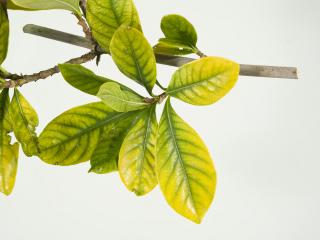Fertilisers
When applying fertilisers a well balanced general purpose product containing both essential and trace elements is recommended. Trace elements are required in small amounts and should be used sparingly.
On sandy soils small amounts of fertiliser should be used frequently, to ensure a steady supply of nutrients to the plant. A time saving alternative is to use controlled release fertilisers. On heavier soils apply fertiliser in greater quantities, but less often.
Plants can also suffer from nutrient toxicity if too much of a particular nutrient is applied. Water plants before fertiliser application and ensure the fertiliser is watered in well after application, to avoid burning of the plants.
Liquid fertilisers or trace elements in a liquid form, applied to the foliage of the plant, are one of the quickest ways of solving nutrient deficiencies.
Deficiency symptoms
Nitrogen
Nitrogen is a necessary element for leaf growth and blossom formation. It is an important component in chlorophyll which is essential for photosynthesis. If nitrogen is deficient, the oldest leaves appear pale and lack the lustre of healthy ones. Yellowing appears at leaf tips and will affect all the leaves. Apply fertilisers high in nitrogen such as sulphate of ammonia or blood and bone. Organic matter and manures can also be added to the soil.
Phosphorus
Phosphorus is essential for the development of flowers, fruit and roots. It is a mobile nutrient and is moved from older leaves to the newly developing tissue. Older leaves turn a darker green followed by a purplish tint starting from the leaf margins. Leaf tips dry off. In fruit trees, flowering and fruiting may be affected. Deficiency symptoms are more prevalent during cold, wet conditions. To correct the deficiency apply solid or liquid phosphate fertilisers.
Potassium
Potassium is also required for flower and fruit formation and thickening of cell walls. It is essential for the lengthening of stems. Mature leaves show a browning and drying of the upper surface and puckering on the margins. Darkening appears between the leaf veins. The stalks are thin and shortened. The fruits may fail to develop full colour, be pulpy in texture and lack flavour. To correct the deficiency apply sulphate of potash.
Magnesium
Magnesium is essential for photosynthesis and the formation of proteins and chlorophyll. It moves freely within the plant and is taken from the older leaves to supplement new growth. Lower leaves are first affected, yellowing from the tip downwards. Dead spots appear. Deficiencies occur on sandy acid soils and affect palms and citrus. To correct the deficiency apply magnesium sulphate (Epsom salts) or dolomite (magnesium-calcium-carbonate).
Zinc
Citrus trees suffering from a zinc deficiency show yellowing between the leaf veins, rolling of the margins and smaller leaves than normal. Zinc becomes unavailable in soils which have high pH. It is not a very mobile nutrient so a foliar spray of zinc and manganese is recommended for fruit set.
Iron
A condition often referred to as lime induced chlorosis affects acid loving plants that are unable to take up iron in alkaline soils. The newer leaves become pale green, yellow and, in severe cases, white. Veins remain green. This is a common occurrence on coastal alkaline soils. To correct the deficiency reduce the pH of soil with ammonium sulphate or agriculture sulphur, and apply iron sulphate. A foliar feed with a complete liquid fertiliser will help correct this problem.
Manganese
Manganese deficiency causes yellowing between the veins of new foliage. In extreme cases new palm fronds emerge withered and dead. This is referred to as frizzletop, and commonly occurs on alkaline soils. To correct the deficiency apply manganese sulphate. During summer yellowing appears on cycads as manganese is diverted from older fronds to support a flush of new growth. Yellow spots merge into a mass. A spray with the fungicide mancozeb, which contains manganese, is beneficial. This deficiency can appear on either new or older leaves.
Sulphur
Sulphur is a component in the formation of chlorophyll. Deficiencies result in yellow leaves and stunted growth. Sulphur can be used to lower the pH of alkaline soils. To correct the deficiency apply sulphur fertiliser such as sulphate of potash or ammonium sulphate rather than agricultural sulphur.
Calcium
Symptoms are more prevalent on the fruits than on the leaves. Fruits like tomatoes, plums and olives show a blemish on the blossom end of fruit. To correct the deficiency, apply calcium nitrate early in the season.
Iron and manganese deficiency on acid preferring plants
Symptoms show yellowing between the veins, which remain dark green. This is a common condition in soil with a high pH, and particularly on citrus, roses and gardenias. To correct the deficiency add iron sulphate or iron chelate and manganese sulphate to the soil.


